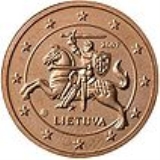
Lithuanian euro coins
Encyclopedia
Lithuanian euro coins share a similar national side for all eight coins, and are expected to be issued from 2013 on. The difference between the coins are that one and two euro coins have vertical lines on the outer circle, the fifty, twenty and ten cent coins have horizontal lines on the outer circle, and the five, two and one cent coins have no lines on the outer circle. The design featuring the Vytis symbol and the word Lithuania
was announced 11 November 2004, and was created by the sculptor Antanas Žukauskas.
However, a recent analysis of SEB bankas says that Lithuania cannot hope to adopt the euro before 2013 due to the high current inflation which reached 11% in October 2008, well above the Maastricht criterion of 4.2%.
.
originally required that all members of the European Union
join the euro once certain economic criteria
are met. Lithuania meets 2 out of the 5 criteria.
Lithuania
Lithuania , officially the Republic of Lithuania is a country in Northern Europe, the biggest of the three Baltic states. It is situated along the southeastern shore of the Baltic Sea, whereby to the west lie Sweden and Denmark...
was announced 11 November 2004, and was created by the sculptor Antanas Žukauskas.
However, a recent analysis of SEB bankas says that Lithuania cannot hope to adopt the euro before 2013 due to the high current inflation which reached 11% in October 2008, well above the Maastricht criterion of 4.2%.
Lithuanian euro design
For images of the common side and a detailed description of the coins, see euro coinsEuro coins
There are eight euro coin denominations, ranging from one cent to two euros . The coins first came into use in 2002. They have a common reverse, portraying a map of Europe, but each country in the eurozone has its own design on the obverse, which means that each coin has a variety of different...
.
Status
The Maastricht TreatyMaastricht Treaty
The Maastricht Treaty was signed on 7 February 1992 by the members of the European Community in Maastricht, Netherlands. On 9–10 December 1991, the same city hosted the European Council which drafted the treaty...
originally required that all members of the European Union
European Union
The European Union is an economic and political union of 27 independent member states which are located primarily in Europe. The EU traces its origins from the European Coal and Steel Community and the European Economic Community , formed by six countries in 1958...
join the euro once certain economic criteria
Convergence criteria
The euro convergence criteria are the criteria for European Union member states to enter the third stage of European Economic and Monetary Union and adopt the euro as their currency...
are met. Lithuania meets 2 out of the 5 criteria.
| Convergence criteria | |||||
| | Inflation rate Inflation rate In economics, the inflation rate is a measure of inflation, the rate of increase of a price index . It is the percentage rate of change in price level over time. The rate of decrease in the purchasing power of money is approximately equal.The inflation rate is used to calculate the real interest... 1 | | Government Government Government refers to the legislators, administrators, and arbitrators in the administrative bureaucracy who control a state at a given time, and to the system of government by which they are organized... finances | | ERM II European Exchange Rate Mechanism The European Exchange Rate Mechanism, ERM, was a system introduced by the European Community in March 1979, as part of the European Monetary System , to reduce exchange rate variability and achieve monetary stability in Europe, in preparation for Economic and Monetary Union and the introduction of... membership | | Long-term interest rate Interest rate An interest rate is the rate at which interest is paid by a borrower for the use of money that they borrow from a lender. For example, a small company borrows capital from a bank to buy new assets for their business, and in return the lender receives interest at a predetermined interest rate for... 2 |
||
| annual government Government Government refers to the legislators, administrators, and arbitrators in the administrative bureaucracy who control a state at a given time, and to the system of government by which they are organized... deficit to GDP Gross domestic product Gross domestic product refers to the market value of all final goods and services produced within a country in a given period. GDP per capita is often considered an indicator of a country's standard of living.... | gross government debt Government debt Government debt is money owed by a central government. In the US, "government debt" may also refer to the debt of a municipal or local government... to GDP Gross domestic product Gross domestic product refers to the market value of all final goods and services produced within a country in a given period. GDP per capita is often considered an indicator of a country's standard of living.... |
||||
| Reference value | max 1.0% | max 3% | max 60% | min 2 years | max 6.0% |
 Lithuania LithuaniaLithuania Lithuania , officially the Republic of Lithuania is a country in Northern Europe, the biggest of the three Baltic states. It is situated along the southeastern shore of the Baltic Sea, whereby to the west lie Sweden and Denmark... (May 2010) |
2.0% | 8.4% | 38.6% | Yes | 12.1% |
| 1 No more than 1.5% higher than the 3 best-performing EU member states. HICP rate as published by the ECB. 2 No more than 2% higher than the 3 best-performing EU member states. |
|||||

